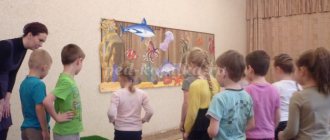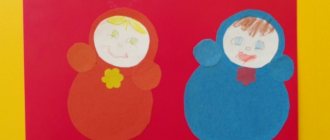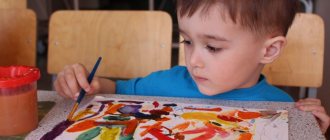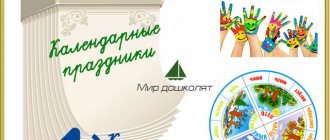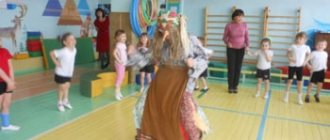DIY crafts for kindergarten on the topic of traffic rules (traffic rules) + photos
It is known that habitual patterns of behavior formed in early childhood accompany a person throughout his life, which is why it is so important to teach children the rules of the road, as well as safe behavior on the streets and roads.
The task of adults is to give the child the basic necessary knowledge that will form a responsible attitude towards their own health and life.
The creation of crafts dedicated to the topic of traffic rules will help solve the above problems.
The importance of creating crafts on the topic of traffic rules in kindergarten
Making crafts based on traffic rules is simple and fun. The child fantasizes, develops fine motor skills, spatial thinking, imagination, mental and creative abilities, and at the same time masters and remembers the most important information.
A colorful and attractive layout, created with your own hands, will help explain, show and play with the rules of behavior on the streets and roads of the city in an intelligible and interesting form for the child: how and where you can cross the road, how to get on and off the bus correctly, how to read the symbols depicted on road signs, etc.
A colorful and attractive layout, created with your own hands, will help explain, show and play with traffic rules in an intelligible and interesting form for a child.
It is advisable to teach children the rules of behavior on the road in a playful way, because play is the leading activity of preschoolers.
The tasks of creating crafts on the topic of traffic rules in kindergarten:
- expand the range of original creative techniques, various forms and methods of pedagogical work to increase the effectiveness of teaching students traffic rules;
- develop knowledge about the symbolic meaning of traffic light colors;
- introduce the basics of game modeling;
- consolidate and systematize knowledge about road signs and rules of safe behavior on the roads of a city or town, create a culture of behavior on the street;
- improve fine motor skills and manual skills;
- develop sensory perception, spatial and figurative thinking, intellectual and creative abilities;
- enrich the vocabulary with new concepts: roadway, transport, intersection, inspector, pedestrians, etc.;
- cultivate independence, organization, accuracy and work culture.
Forms and techniques for making crafts
A craft on the topic of traffic rules can be designed as:
- object - a single volumetric toy or flat applique (traffic light, traffic controller, etc.);
- plot-based collective composition (“Crossroads”, “City Streets”, “Safe Traffic”, etc.) - children work in subgroups, combining various techniques and methods of work, compose and tell their own plot stories, make up a single composition from individual toys and they play on it, “revitalizing” the created characters with the help of role-playing voice acting.
Techniques used to make crafts:
- drawing made with colored pencils and paints;
- applique, plot composition made of colored paper, for example, various “Traffic lights”, road signs;
- collage is a combined technique of appliqué made from paper and natural material with elements of drawing, origami, modeling, and plasticine;
- designing flat and three-dimensional crafts from cardboard, paper, waste material;
- layout using construction and paper-plastic techniques (“Safe road to kindergarten”, “Roads of our city”).
Children 2–3 years old will enthusiastically engage in simple step-by-step construction from paper or gluing parts prepared by the teacher onto a base using the applied appliqué technique.
Making crafts with your own hands will develop in children of primary preschool age the basic skills of constructing a simple composition, help consolidate knowledge of geometric shapes, and improve the ability to distinguish primary colors.
In addition to learning traffic rules, children develop fine motor skills in the process of making crafts.
Students in the middle group will be interested in independently cutting out simple silhouettes of parts for an appliqué using a template, choosing natural material for a collage, and making an original craft from a plastic bottle or used CDs based on step-by-step instructions.
Children of this age can be offered more complex appliqué techniques, for example, modular or cut-off. Filling out a schematic drawing with multi-colored pieces of torn paper and creating mosaic applications from a variety of geometric shapes is perceived by children as an entertaining game.
Students in the middle group can be offered more complex appliqué techniques, for example, modular or cut-off
Older preschoolers are able to independently create crafts based on their own ideas, since they have already mastered the basic techniques of drawing, design and appliqué.
The children are happy to take part in educational creative projects, creating individual works and amazing large collective models in the form of plot compositions.
Unusual works are obtained by combining a variety of techniques, for example, three-dimensional design from cylinders and cones and drawing, appliqué from twisted elements (quilling) and origami.
New techniques may seem complicated, but if you follow the step-by-step instructions and the competent participation of the teacher, you can get high-quality creative work.
Photo gallery: examples of collective work
Ready-made crafts of pupils can be arranged in the form of an exhibition or a game model. The use of various materials in their work allows the children to choose the most attractive for them. By performing collective work, preschoolers learn to cooperate. The finished model can be used as a teaching aid. The bulk applique technique requires special care. When performing a collective applique, children can distribute responsibilities: who draws, cuts, glues
Photo gallery: crafts made using various techniques
The plasticineography technique requires patience and thoroughness. All kinds of boxes are perfect as a basis for models of traffic lights, houses or cars. Old CDs can be used as the basis for crafts. In some cases, parents help children work on crafts. By creating a collage using various techniques, children develop their creative abilities. The applied applique technique is suitable for the youngest students To make crafts using the loose applique technique, you will need to cut or tear the paper into small pieces Girls will happily master the decorative applique technique New techniques and approaches will help diversify familiar crafts “Emotional traffic light” will help kids remember its signals
Pedagogical techniques
Teaching methods are traditionally built on an imitative basis and gradually become more complex:
- At the first stage, a detailed analysis of a sample of the future product is carried out:
- in the younger group, a craft made in advance by the teacher is used as a model;
- in the middle group, children can be asked to look at a picture or drawn image;
- Children 6–7 years old are already able to analyze a diagram or model of a toy.
- Stage two - children are taught to plan and think about step-by-step progress towards a goal, and are taught a holistic perception of the entire work process. It is specified in what sequence the parts are cut or made, from what material, and which tool will be preferable.
Source: https://melkie.net/detskoe-tvorchestvo/podelka-v-detskiy-sad-na-temu-pravila-dorozhnogo-dvizheniya.html
Traffic light
For it you will need cardboard in black, red, green and yellow. This traffic rules craft will decorate a child’s room. You will need to cut out the base from black cardboard according to the template. You can draw it yourself or pre-print the finished version.
You also need to cut out three circles and stick them on the base. You can make opening windows with poems. If you add eyes and a nose to a traffic light, you will get a fairy-tale hero. A small model made of plasticine or cardboard can be used to create a model of a city street.
You will get an original product if you use fabric for it. Sewing a traffic light is not difficult, you just need to select bright pieces of material. The finished product is hung on the wall.
Teaching children traffic rules in preschool educational institutions: ready-made questions
It’s never too early to introduce children to traffic rules (traffic rules) in kindergarten.
Understand the rules of behavior on the roadway, read the most important signs, know the responsibilities of road users - children of preschool age should be able to do all this.
As they grow older, the topic of traffic rules in preschool educational institutions is revealed more deeply, and repetition of materials from month to month, from year to year helps preschoolers firmly assimilate new knowledge and practice the skills of being safe on the road.
Classes on traffic rules in a preschool educational institution are something that the teacher must include in the thematic calendar. Whatever form these classes take, they help reduce the percentage of accidents involving children and teach children a culture of behavior on the roadway.
Familiarity with the rules of the road helps:
- develop coordination of preschoolers;
- practice actions in traffic conditions until they become automatic and develop reaction speed;
- teach children the basic rules of behavior on and near the road.
What you need to tell children in preschool educational institutions about traffic rules
It’s not enough to explain to your child that they need to look at the traffic lights and cross the road at the zebra crossing. A child in kindergarten should have an idea of the types of cars, the structure of the road lane and various pedestrian crossings.
Here are the first rules that children in the group must learn:
- You can cross the road only when the light is green and at the zebra crossing.
- You need to walk next to a line of cars on the sidewalk, and if there is none, then move along the side of the road towards the traffic.
- Before crossing, first look to the left, and at the dividing strip - to the right.
- You need to learn important road signs and signs.
Find out in the recommendations in the magazine “Handbook for the Director of a Preschool Institution”
Find out now
To study road signs, preschoolers are asked to study pictures depicting them. For example, these:
Also, children already in younger groups need to identify traffic risk areas and explain how to avoid them.
- A second car may fly out from behind a parked car, so before moving, you need to look at the entire road at once.
- A red traffic light may turn on in the middle of the road: you need to stay in the middle so that cars on both sides can safely pass the person.
- Someone faster may be driving behind a slow-moving car, so you should only cross the road when the cars have completely stopped.
Children in the middle and senior groups of preschool educational institutions should know more about traffic rules:
- who is considered a road user (pedestrian, driver, traffic police inspector, passenger) and which of them behaves on the road;
- basic concepts of road traffic: roadway, shoulder, sidewalk, dividing strip, intersection, pedestrian crossing;
- types of transport: car, moped, motorcycle, bicycle, bus, trolleybus, tram, minibus;
- traffic lights signals and colors;
- places where you can cross the roadway;
- places where you can walk along the road;
- rules for using public transport;
- features of crossing railway tracks;
- rules for traveling on the road by bicycle.
Pupils of senior preschool age systematize the knowledge acquired earlier and generalize concepts. The teacher of the senior and preparatory school no longer just introduces children to traffic rules, but invites children to solve problems in a playful way. For example, what should you do if a pedestrian’s light is green, but a moving car continues to drive fast and does not brake?
How to practice traffic rules with children in preschool educational institutions
Studying traffic rules in kindergarten is part of the educational process, and, therefore, should be structured according to the Federal State Educational Standard. Explaining traffic rules to children in preschool educational institutions can be included in any of the types of classes that provide for federal standards. Here are just a few examples.
- An integrated lesson, when in one lesson preschoolers engage in different types of activities: creative, mobile, speech. It’s a good idea to build such an activity with a guest character, whom children teach to follow traffic rules in different ways: by drawing, talking, singing, showing.
- A thematic lesson combines one topic of study (for example, signs, public transport or traffic signals) in different classes: music, physical education, speech development, art.
- A collective task in which the entire group of preschool educational institutions does a common project. For example, an applique with a picture of a street.
- A game activity during which children work in mini-groups and then discuss what they have done.
- An excursion lesson in which preschoolers study the nearby roadway and relate their knowledge to reality.
In order for children to thoroughly remember the rules of the road, the teacher must create conditions under which they:
- see the information;
- they will hear her;
- apply new knowledge.
For this you should use:
- visual materials;
- various speech techniques;
- gaming and creative tasks.
The effectiveness of teaching children traffic rules depends on the equipment of the preschool educational institution, but, first of all, on the skill of the teacher. A teacher explaining traffic rules must combine four types of teaching techniques in a lesson:
- Visual.
- Verbal.
- Gaming.
- Practical.
Visual techniques for teaching traffic rules to children in preschool educational institutions
Explaining traffic rules using visual images is one of the most effective techniques. Visibility can be organized
- pictures, for example, with images of traffic signs or traffic controller signals;
- presentations and videos that broadcast interesting stories, for example, notes on the development of traffic or a cartoon on the topic of traffic rules;
- demonstrations, when the teacher shows by example the correct action.
An example of a picture that is suitable for a lesson on learning traffic rules for a preschooler:
Verbal techniques for teaching traffic rules to children in preschool educational institutions
Using verbal techniques will not only help explain traffic rules to children, but will also help the teacher check how the material has been learned. Such techniques include:
- conversations;
- fairy tales;
- riddles and poems;
- reading.
It is most convenient to structure a conversation with preschoolers according to the question-answer principle. “Which traffic lights allow a pedestrian to move?”, “Where do several roads intersect?” and so on.
Riddles and rhymes help the teacher quickly switch the attention of preschoolers to the topic after a pause or hitch. For children of primary preschool age, agreements are usually used, and in the senior and preparatory groups of preschool educational institutions, more complex poems are used.
The color is green - Come in! Yellow - Wait a little. Well, if it’s red - Stop! The passage is dangerous!
A traffic light has three eyes. Well, remember them, my friend, Walk the streets so that soon you can do it on your own. That red eye... Be afraid of it! When it burns, there is no way. Flashing yellow - get ready! Green light - go!
At any intersection we are greeted by a traffic light. And it’s very easy to start a conversation with a pedestrian: The light is green - come on in! Yellow - better wait! If the light turns red, it means it’s dangerous to move! Stop! Let the tram pass, be patient. Learn and respect the rules of the road.
And recently we have a traffic light near our house. He burns day and night, trying to help everyone. If the red light comes on, don't rush. Everyone knows that red is dangerous for the road.
And don’t go to the yellow one, but stand quietly and wait. Take mom's hand and wait. Together with us, all the people are patiently waiting for the green one, To move forward.
Here - the green flashed! Soon! He winked: “You can’t stand!” Soon the color of the traffic light will change to red again.
Reading, as a rule, is used more in older groups of preschool educational institutions, in which preschoolers can read simple texts themselves. Another option: the teacher reads stories about traffic to the children. It is better to use special children's literature on the topic of traffic rules:
- “Uncle Styopa is a policeman”, “My street” (S. Mikhalkov);
- “The Driver” (B. Zakhoder);
- “Traffic Light” (G. Georgiev);
- “Policeman” (N. Nosov);
- “Why do we need a traffic light” (O. Tarutin);
- “Traffic rules” (V. Golovko).
Game techniques for explaining traffic rules in preschool educational institutions
Playful activities should become the main focus when teaching traffic rules to children. During the game, preschoolers repeat new concepts, practice correct behavior on the road, develop speech and coordination of movements.
Five types of games are appropriate to use for preschoolers to practice various traffic situations.
- Didactic games on traffic rules, which have clear rules and a learning task.
- Role-playing games, where children copy the behavior patterns of different road users. For example, they role-play traveling on a bus or crossing a road without a traffic light.
- Outdoor games are good to use while walking.
- Theatrical games based on traffic rules in preschool educational institutions can take place according to a certain scenario, in which children play according to a given plot, or they themselves are directors and doll-actors.
- Finger games are convenient to carry out in a group of primary preschool age and also to role-play different situations on the road.
In kindergarten, a unified card index of traffic rules games is compiled, in which games are divided by topic and type. This work can be carried out by both the methodologist and educators. It is convenient that the same games are used for children of the junior, middle and senior groups of preschool educational institutions. Only the methods of presenting information and its quantity differ.
Practical techniques for explaining traffic rules to preschoolers
All types of games, on the one hand, can be attributed to the processing of received information. On the other hand, the options for activities in which preschoolers can practically master traffic rules do not end there. The practical part of the traffic rules lesson also includes any creative activity using fine motor skills: drawing, appliqué, modeling (traffic lights, transport, signs).
Source: https://www.resobr.ru/article/59376-qqe-16-m8-bezopasnost-dorognogo-dvigeniya-v-doy-znat-i-soblydat
Lapbook
The product will require a folder, which you can make yourself. Crafting traffic rules for school will be an excellent tool for children.
A laptop is made from sheets of A4 or A3 format. It may have a different number of sheets. They are covered with thematic pictures. Envelopes of various shapes are attached to the base, containing cards with interesting tasks, puzzles, and riddles.
A section with traffic signs should be provided. Lapbooks often contain interactive elements that attract children's attention and help them remember information faster.
Moving accordions, circles with arrows, windows with opening shutters will interest children. You can borrow ideas from more experienced craftsmen by looking at their work. They offer many interesting options for creativity.
How to learn traffic rules correctly in kindergarten
July 21, 2014
Unfortunately, children often get into accidents. There are several reasons for this. One of them is a feature of children's memory. Children remember information quickly, but they also quickly forget it. Therefore, it is necessary to regularly conduct traffic rules classes in kindergarten. Moreover, this should be done in accordance with age, in a playful way.
The importance of children learning traffic rules
There are several reasons for such activities. The first is that only well-established traffic rules will help you navigate the road in time. After all, kids have a poorly developed sense of self-preservation, so learning to act according to a pattern is the best way to keep a child safe.
Often, educational institutions become the only place where a child can get information about correct behavior on the road. After all, parents themselves can break the rules by setting a bad example.
The children play very enthusiastically. They may end up on the road without even noticing it. Sometimes they simply forget about the ban on exiting the roadway.
Weak peripheral vision makes it impossible to notice danger in time and react accordingly. Children have a 15% smaller viewing range than adults.
“The short stature of a child in many cases makes him invisible on the road. And his small steps do not allow him to quickly cross the roadway. Children also have poorly developed reflexes. When they see a car, children often do not speed up their pace to leave a dangerous place, but, on the contrary, stop and freeze in fear.”
Traffic rules games
Teaching rules of behavior on the road is the responsibility of parents and employees of educational institutions, including preschools.
The first form of working with children is posting visuals on a given topic. A colorful traffic rules corner in a kindergarten should remind children in an accessible form of how to behave on the road.
Materials where favorite cartoon characters appear on the road are well received. Such images inspire the child’s trust and desire to imitate.
But it is much more useful to perceive information in a playful way.
Games on traffic rules in kindergarten help to remember the most important points of behavior on the road. In essence, these are collective activities, the form of which is playful.
The purpose of such classes is to gain knowledge about traffic lights and what to do when a particular color lights up. They also necessarily include classes on behavior in public transport and boarding rules.
We also cannot ignore the topic of the inadmissibility of games on the roadway.
Game “What will the traffic light tell us?”
At the preparatory stage, the teacher introduces children to traffic lights and talks about the rules of behavior at crossings equipped with traffic lights. Then children reinforce their acquired knowledge in practice through play.
In order to remember what the colors red, yellow and green mean, you need to prepare circles of the corresponding colors. Each child should have three mugs. The teacher, showing a certain color, selects a participant in the game who tells everything he knows about this traffic light. The one who has never made a mistake and correctly told about each color wins.
Game “Crocodile Knowing Traffic Rules”
This game is built on the principle of the well-known game “Crocodile”, when you need to use gestures, poses and signs to show a certain concept that you have wished for. In this version, words are made related to the topic of the road and safety rules on it. It is interesting to think of the following words:
- a pedestrian,
- parking,
- crosswalk,
- crossroads,
- bus,
- trolleybus,
- stop.
Outdoor games according to traffic rules
Children like active outdoor games, so it’s easy to present them with the necessary information in this form.
Game "Running after the traffic light"
The teacher here will play the role of a traffic light. He becomes the first, the children follow him - a train. The guys first pretend to be cars. The teacher has three circles in his hands, he runs and periodically shows the children one or another circle. If yellow or red is shown, the children stop. If it's green, continue running.
At the second stage, children turn into traffic lights. Depending on the circle that the presenter showed, the guys should remind others whether they can cross the road or not.
At the third stage, children are divided into pedestrians and cars. The teacher shows the color of the traffic light, and the children behave accordingly.
The work of a children's institution to instill safe behavior skills on the road is not limited to activities aimed at pupils. It is imperative to organize educational work with parents. A reminder for parents on traffic rules is of great importance. Such visibility does not allow us to relax, reminding us of the dangers that surround children on the streets.
Board game
You will need to print out traffic signs. You need to make two sets. One will be needed for chips, and the second will be used for cards. The signs are glued onto cardboard and cut out. These chips will be distributed to the players.
You will also need cards. Rectangles are cut out of whatman paper, onto which road signs from the second set are glued. You should find poems that are also pasted on the card.
The presenter distributes chips, and then takes out cards one by one and reads the verse. If a player sees that he has such a sign, he receives a card. The winner is the one who quickly collects all the cards that correspond to the chips received at the beginning of the game.
Children will definitely enjoy this interesting craft based on traffic rules. It will help you remember the signs faster and create fewer accidents on the roads.
Soft road signs
Original products are sewn from felt of different colors. Bright and soft to the touch road signs will definitely please your baby. For them, the material of the required colors is selected, the products are filled with padding polyester. Such a craft of traffic rules for kindergarten will not go unnoticed at the competition. You can make several of these toys to use in class.
Another option would be to create soft cubes. Road signs are sewn onto their edges. The child will soon begin to recognize such signs on the way to kindergarten or school. He will look at them with interest and remember them, which will definitely be useful to him in the future.

